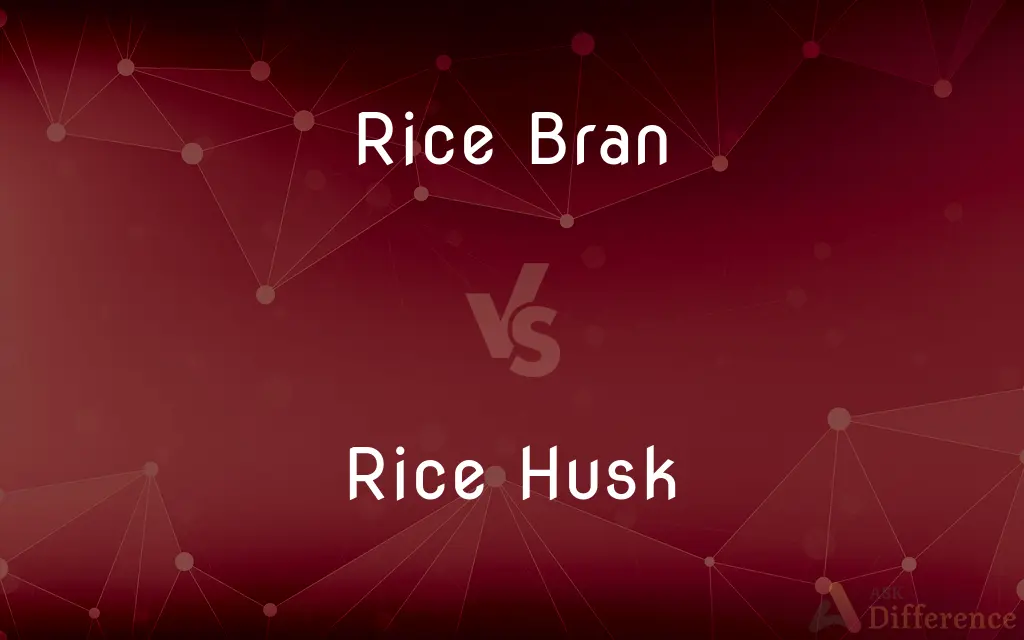Rice Bran vs. Rice Husk — What's the Difference?
By Tayyaba Rehman — Published on October 1, 2023
Rice Bran is the nutrient-rich outer layer of rice grain, while Rice Husk is the hard protective outer shell.

Difference Between Rice Bran and Rice Husk
Table of Contents
ADVERTISEMENT
Key Differences
Rice Bran is derived from the rice kernel and is situated between the inner white rice grain and the outer husk. Rich in vitamins, minerals, and oils, it's often processed for culinary uses. On the other hand, Rice Husk, also known as rice hull, is the tough, outer covering of the rice grain, which serves as a protective shield for the delicate kernel inside.
The nutritional content of Rice Bran makes it a sought-after ingredient in various cuisines. It contains essential fatty acids, vitamin E, and fiber, among other beneficial components. In contrast, Rice Husk doesn't have notable nutritional benefits but plays a crucial role in protecting the grain from physical and environmental damages.
Rice Bran, given its nutrient-rich nature, is used to extract rice bran oil, a popular cooking medium in various cultures. Its presence ensures that even the polished white rice retains some nutritional value. Rice Husk, conversely, is majorly considered agricultural waste. However, its silica content has led to applications in industries such as construction and insulation.
While Rice Bran can be consumed and offers health benefits, Rice Husk is inedible. That said, Rice Husk has found uses in sustainable energy production, as it can be used to generate electricity and heat when burned.
Comparison Chart
Position on Grain
Layer between inner white rice and the husk
Outermost protective covering of the rice grain
ADVERTISEMENT
Nutritional Value
Rich in vitamins, minerals, and oils
Lacks significant nutritional benefits
Major Uses
Cooking, oil extraction
Construction, insulation, energy production
Edibility
Edible and nutrient-rich
Inedible
Appearance
Powdery or flaky
Hard and protective
Compare with Definitions
Rice Bran
Rice Bran is a source of vitamins and minerals.
Health enthusiasts recommend adding Rice Bran to the diet for its nutritional benefits.
Rice Husk
Rice Husk can be used for energy production.
Many industries burn Rice Husk as a sustainable energy source.
Rice Bran
It sits between the inner rice and the husk.
After removing the Rice Husk, the Rice Bran becomes more visible.
Rice Husk
Rice Husk is tough and inedible.
While Rice Husk protects the grain, it's not suitable for consumption.
Rice Bran
Rice Bran contains dietary fiber.
Including Rice Bran in meals can aid digestion due to its fiber content.
Rice Husk
Rice Husk is the protective outer shell of rice grain.
The Rice Husk ensures the inner grain remains undamaged during harvesting.
Rice Bran
It is used to extract rice bran oil.
The oil in my kitchen is extracted from Rice Bran.
Rice Husk
It finds applications in industrial sectors.
Due to its silica content, Rice Husk is used in construction projects.
Rice Bran
Rice Bran is the nutrient-rich layer of rice grain.
Rice Bran is often processed to extract its beneficial oils.
Rice Husk
It is also referred to as rice hull.
Rice mills often discard large quantities of Rice Husk after processing.
Common Curiosities
What are the benefits of Rice Bran?
Rice Bran is rich in essential fatty acids, vitamin E, and fiber, making it nutritionally valuable.
What is Rice Bran?
Rice Bran is the nutrient-filled layer situated between the white rice grain and the outer husk.
Can I eat Rice Husk?
No, Rice Husk is inedible and is usually discarded or used for other purposes.
Where is Rice Husk located?
Rice Husk is the hard, protective outer shell of the rice grain.
What happens to the discarded Rice Husk?
It can be used as biofuel, in construction, or for insulation, among other uses.
Are there any industrial uses for Rice Husk?
Yes, Rice Husk is used in construction, insulation, and as a biofuel for energy production.
Can Rice Bran be added to meals?
Yes, Rice Bran can be added to meals for its nutritional benefits and fiber content.
Why is Rice Husk hard?
It's nature's design to protect the delicate rice grain from environmental and physical damages.
How does Rice Husk contribute to sustainability?
Rice Husk can be burned for energy, offering a more sustainable alternative to fossil fuels.
What's the significance of Rice Husk in rice production?
Rice Husk acts as a protective shield for the grain, ensuring it remains undamaged during harvesting.
Is Rice Bran oil extracted from Rice Husk?
No, Rice Bran oil is extracted from Rice Bran, not the husk.
Is Rice Bran a byproduct of rice milling?
Yes, Rice Bran is obtained during the milling process when the outer husk is removed.
Is Rice Bran edible?
Yes, Rice Bran is edible and is often used in various culinary applications.
Can Rice Bran help in improving digestion?
Yes, due to its fiber content, Rice Bran can aid digestion when added to meals.
Is there any nutritional value in Rice Husk?
Unlike Rice Bran, Rice Husk lacks significant nutritional benefits and is mainly protective in function.
Share Your Discovery

Previous Comparison
Consignment vs. Partnership
Next Comparison
Ethanol vs. GasolineAuthor Spotlight
Written by
Tayyaba RehmanTayyaba Rehman is a distinguished writer, currently serving as a primary contributor to askdifference.com. As a researcher in semantics and etymology, Tayyaba's passion for the complexity of languages and their distinctions has found a perfect home on the platform. Tayyaba delves into the intricacies of language, distinguishing between commonly confused words and phrases, thereby providing clarity for readers worldwide.
















































